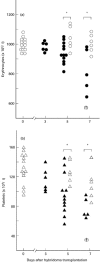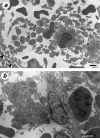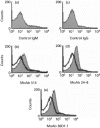Induction of microthrombotic thrombocytopenia in normal mice by transferring a platelet-reactive, monoclonal anti-gp70 autoantibody established from MRL/lpr mice: an autoimmune model of thrombotic thrombocytopenic purpura
- PMID: 10606963
- PMCID: PMC1905520
- DOI: 10.1046/j.1365-2249.2000.01116.x
Induction of microthrombotic thrombocytopenia in normal mice by transferring a platelet-reactive, monoclonal anti-gp70 autoantibody established from MRL/lpr mice: an autoimmune model of thrombotic thrombocytopenic purpura
Abstract
MRL/MpJ-lpr/lpr (MRL/lpr) mice spontaneously develop immune complex-mediated glomerulonephritis and thrombocytopenia. Although the presence of cross-reactive anti-phospholipid antibodies in sera of MRL/lpr mice has been demonstrated, possible relationships between detected autoantibodies and the development of thrombocytopenia have not been elucidated. Recent genetic analyses in a few different strains of lupus-prone mice have pointed out a close correlation between autoantibodies reactive with endogenous retroviral env gene product, gp70, and the development and severity of glomerulonephritis. In the process of establishing possibly nephritogenic anti-gp70 autoantibody-producing hybridoma cells from MRL/lpr mice, we identified an IgG2a-producing anti-gp70 hybridoma clone that induced microvascular intraluminal platelet aggregation, thrombocytopenia, and amenia upon transplantation into syngeneic non-autoimmune mice. This and two other anti-gp70 antibodies bound onto the surface of mouse platelets, and purified IgG2a of the anti-gp70 autoantibody induced glomerular lesions with characteristics of thrombotic thrombocytopenic purpura when injected into non-autoimmune mice. The pathogenic anti-gp70 autoantibody specifically precipitated a platelet protein with an approximate relative molecular mass of 40 000.
Figures






Similar articles
-
Roles of endogenous retroviruses and platelets in the development of vascular injury in spontaneous mouse models of autoimmune diseases.Int J Cardiol. 2000 Aug 31;75 Suppl 1:S65-73; discussion S75-6. doi: 10.1016/s0167-5273(00)00193-5. Int J Cardiol. 2000. PMID: 10980339
-
Establishment of monoclonal anti-retroviral gp70 autoantibodies from MRL/lpr lupus mice and induction of glomerular gp70 deposition and pathology by transfer into non-autoimmune mice.J Virol. 2000 May;74(9):4116-26. doi: 10.1128/jvi.74.9.4116-4126.2000. J Virol. 2000. PMID: 10756024 Free PMC article.
-
Parallel sets of autoantibodies in MRL-lpr/lpr mice. An anti-DNA, anti-SmRNP, anti-gp70 network.J Exp Med. 1987 Feb 1;165(2):483-99. doi: 10.1084/jem.165.2.483. J Exp Med. 1987. PMID: 2950197 Free PMC article.
-
Nephritogenic antibodies in MRL/lpr lupus mice: molecular characteristics in pathological and genetic aspects.Tohoku J Exp Med. 1994 May;173(1):65-74. doi: 10.1620/tjem.173.65. Tohoku J Exp Med. 1994. PMID: 7809912 Review.
-
Unique site of IgG2a and rheumatoid factor production in MRL/lpr mice.Immunol Rev. 1997 Apr;156:103-10. doi: 10.1111/j.1600-065x.1997.tb00962.x. Immunol Rev. 1997. PMID: 9176703 Review.
Cited by
-
Role of natural killer cells in resistance against friend retrovirus-induced leukemia.J Virol. 2001 Apr;75(7):3152-63. doi: 10.1128/JVI.75.7.3152-3163.2001. J Virol. 2001. PMID: 11238842 Free PMC article.
-
Thrombotic microangiopathic haemolytic anaemia and antiphospholipid antibodies.Ann Rheum Dis. 2004 Jun;63(6):730-6. doi: 10.1136/ard.2003.007245. Ann Rheum Dis. 2004. PMID: 15140782 Free PMC article. Review.
References
-
- Moake JL. Studies on the pathophysiology of thrombotic thrombocytopenic purpura. Semin Hematol. 1997;34:83–9. - PubMed
-
- Ruggenenti P, Luts J, Remuzzi G. Pathogenesis and treatment of thrombotic microangiopathy. Kidney Int. 1997;51(Suppl. 58):S97–S101. - PubMed
-
- Neild GH. Hemolytic uremic syndrome/thrombotic thrombocytopenic purpura. pathophysiology and treatment. Kidney Int. 1998;53(Suppl. 64):S45–S49. - PubMed
-
- Tandon NN, Rock G, Jamieson GA. Anti-CD36 antibodies in thrombotic thrombocytopenia purpura. Br J Haematol. 1994;88:816–25. - PubMed
-
- Schultz DR, Arnold PI, Jy W, et al. Anti-CD36 autoantibodies in thrombotic thrombocytopenic purpura and other thrombotic disorders: identification of an 85kD form of CD36 as a target antigen. Br J Haematol. 1998;103:849–57. - PubMed
Publication types
MeSH terms
Substances
LinkOut - more resources
Full Text Sources
Molecular Biology Databases

